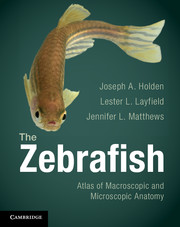Book contents
- Frontmatter
- Contents
- Preface
- Acknowledgments
- Chapter 1 Introduction
- Chapter 2 Cross section and longitudinal section atlas
- Chapter 3 Integument (skin)
- Chapter 4 Digestive system
- Chapter 5 Respiratory system
- Chapter 6 Circulatory system
- Chapter 7 Liver and gallbladder
- Chapter 8 Pancreas
- Chapter 9 Endocrine organs
- Chapter 10 Kidney
- Chapter 11 Reproductive system
- Chapter 12 Sensory systems
- Chapter 13 Central nervous system
- Chapter 14 Miscellaneous structures
- Chapter 15 Musculoskeletal system
- Index
- References
Chapter 12 - Sensory systems
Published online by Cambridge University Press: 05 February 2013
- Frontmatter
- Contents
- Preface
- Acknowledgments
- Chapter 1 Introduction
- Chapter 2 Cross section and longitudinal section atlas
- Chapter 3 Integument (skin)
- Chapter 4 Digestive system
- Chapter 5 Respiratory system
- Chapter 6 Circulatory system
- Chapter 7 Liver and gallbladder
- Chapter 8 Pancreas
- Chapter 9 Endocrine organs
- Chapter 10 Kidney
- Chapter 11 Reproductive system
- Chapter 12 Sensory systems
- Chapter 13 Central nervous system
- Chapter 14 Miscellaneous structures
- Chapter 15 Musculoskeletal system
- Index
- References
Summary
Olfactory sac
The olfactory sacs are paired organs, anterior to the eyes and lying above and dorsal to the oropharynx. They are continuous with external nostrils and consist of sensory receptor cells admixed with goblet and ciliated cells (Figure 12.1). Processes from the receptor cells lead to the olfactory bulbs in the brain. The olfactory sacs consist of folded lamella to increase surface area (Figure 12.2). The paired organs receive water from an inflow tract through the nostrils. Odorants interact with receptor cells and signal through the olfactory tracts leading to the olfactory lobe (Figure 12.3) of the brain. The olfactory epithelium contains two types of receptors, ciliated and microvillous. The crypt neuron axons lead into the olfactory tracts and to the olfactory bulb where they terminate on structures termed glomeruli.
Eye
The eyes of fish lie anterior and inferior to the brain and are structurally similar to the eyes of other vertebrates including mammals (Figure 12.4). Light enters the eye through the transparent cornea (Figure 12.5). Because of the aqueous environment in which fishes live, the cornea requires little refractive power to bend incoming light waves. Thus the cornea in fish is relatively thin. As in mammals, the iris controls the amount of light passing through the pupil. The lens of the fish is nearly spherical and focuses light onto the retina (Figure 12.6). Focusing is achieved by varying the distance between the lens and the retina rather than changing the shape of the lens.
The retina is composed of five layers. The order from outer- to innermost layer is: (1) pigment epithelium; (2) photoreceptor layer; (3) bi-polar layer (synapses present); (4) ganglion layer; and (5) nerve fiber layer (Figure 12.7). Fish retinas contain two types of cells: rods and cones. The rods are sensitive to low levels of light. The pigmented layer helps protect the rods in high light levels. The cones are responsible for vision in bright light. Four types of cones exist, each characterized by sensitivity to a particular wavelength of light.
- Type
- Chapter
- Information
- The ZebrafishAtlas of Macroscopic and Microscopic Anatomy, pp. 114 - 121Publisher: Cambridge University PressPrint publication year: 2013



